1920s
26 January 1926: First public demonstration of television to members of the Royal Institution by John Logie Baird in his London laboratory.
24–27 May 1927: Baird demonstrates long distance transmission of television pictures over telephone lines from London to Glasgow (438 miles).
20 September 1927: Baird makes first electronic image recordings onto ordinary 78 rpm gramophone records. He called this system ‘Phonovision’.
30 December 1927: Baird demonstrates ‘Noctovision’ (infrared television) to the Royal Institution.
8 February 1928: Baird successfully transmits television pictures across the Atlantic.
3 July 1928: Baird demonstrates colour television.
10 August 1928: Baird demonstrates stereoscopic (3D) television.
5 March 1929: Baird broadcasts television using the BBC’s London transmitter.
30 September 1929: Baird begins regular experimental 30-line television broadcasts. Because there is only one radio transmitter available, sound and vision are transmitted alternately for 2 minutes each.
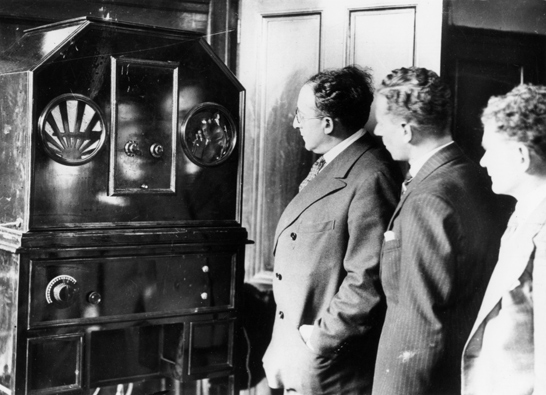
1930s
14 March 1930: Simultaneous sound-and-vision 30-line television transmissions are made possible by a new transmitter (Brookman’s Park).
14 July 1930: First British television drama: Pirandello’s The Man with a Flower in his Mouth.
March 1931: The Gramophone Company (HMV) and Columbia Graphophone Company merge to form a new company, Electrical and Musical Industries (EMI).
3 June 1931: First television outside broadcast—Baird televises the Derby using a mirror drum camera mounted in a caravan.
22 August 1932: The BBC takes over programme-making for the 30-line television service.
September 1932: EMI secretly demonstrate their first electronic television camera.
24 January 1934: EMI demonstrates a workable electronic television camera. They name their camera the ‘Emitron’.
31 January 1935: The Television Advisory Committee, under Lord Selsdon, take evidence on the relative merits of the various worldwide ‘high definition’ (240 lines or greater) television systems. They recommend that both the Baird 240-line mechanical system and the Marconi-EMI 405-line electronic system be developed as alternatives for the proposed new London television station.
2 November 1936: BBC Television begins broadcasting regular high-definition programmes from Alexandra Palace to the London area. The non-compatible Baird and Marconi-EMI systems are used on alternate weeks.
6 February 1937: The Baird system is abandoned on the advice of the Television Advisory Committee.
12 May 1937: First major electronic television outside broadcast: the coronation of King George VI. 9,000 TV sets are sold in the London area.
1 September 1939: British television is shut down immediately at the advent of the Second World War. It is estimated that there are 20,000 TV sets in Britain at this time.
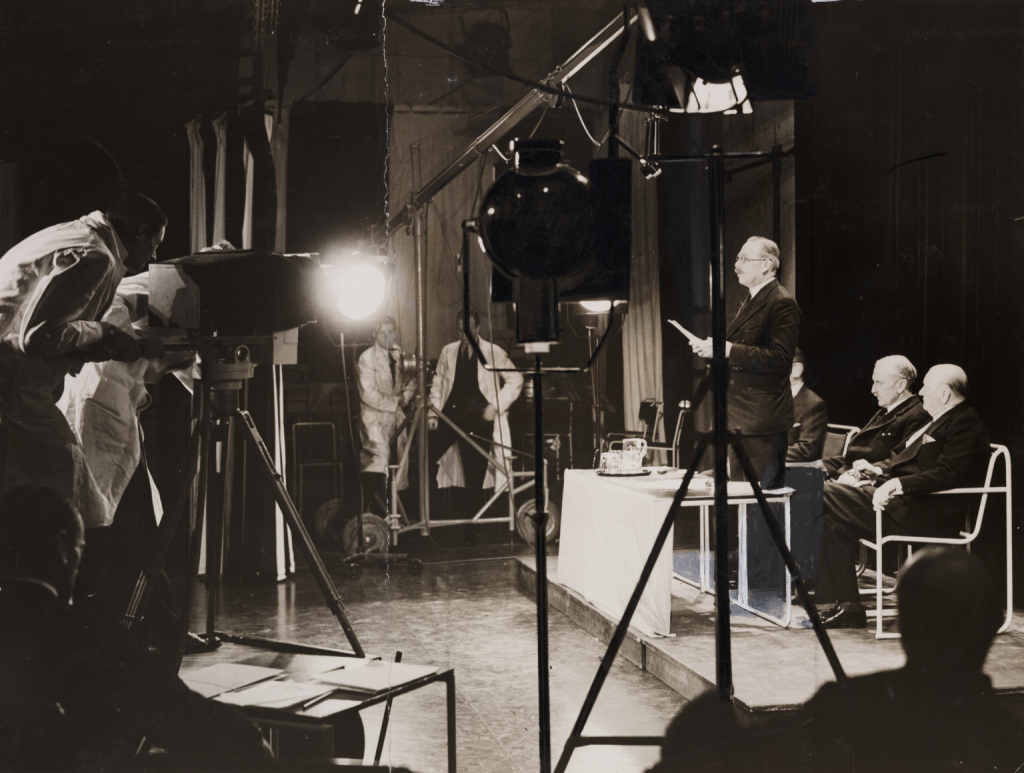
1940s
23 December 1941: Baird gives first demonstration of 600-line electronic stereoscopic television in colour.
7 June 1946: BBC television reopens after the war.
July–August 1948: London hosts the 1948 Summer Olympics, the first Olympic tournament to be broadcast to home television.
17 December 1949: BBC TV Midlands transmitter opens.
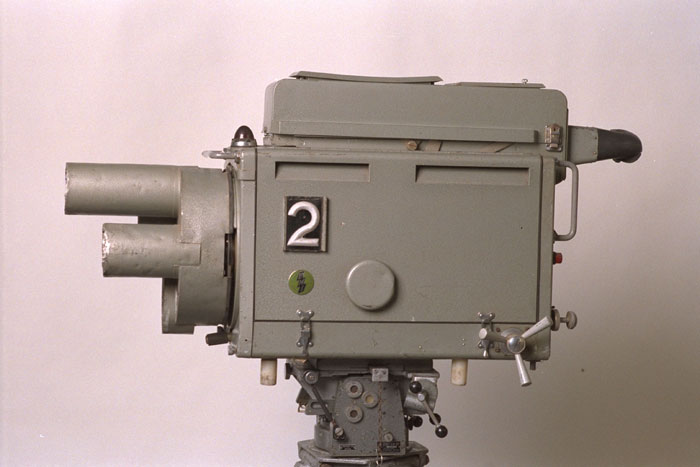
1950s
27 August 1950: First live link from the continent (Calais to London) lays the foundation for the later Eurovision network.
12 October 1951: BBC TV North transmitter opens, serving the North of England.
15 January 1952: BBC TV Scotland transmitter opens.
2 June 1953: Biggest outside broadcast to date: the coronation of Queen Elizabeth II.
22 September 1955: Commercial television (ITV) starts broadcasting in the London area.
21 July 1955: BBC TV Northern Ireland transmitter opens. 95% of the UK can now receive BBC television.
October 1958: Videotape recording starts in Britain; prior to this the only way to record programmes was to use film (telerecording).
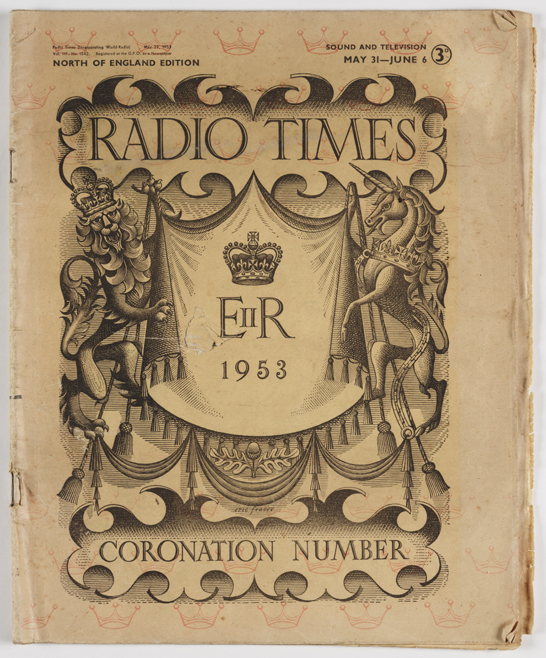
1960s
11 July 1962: First transatlantic satellite link via Telstar.
16 April 1964: First live link from Japan via Telstar II.
20 April 1964: BBC2 scheduled to open on 625 lines. Massive power failure in West London means gala opening night is cancelled. BBC2 opens the following morning, 21 April, with episode of Play School.
2 May 1965: First trans-Atlantic satellite television transmission from the USA is made via the geosynchronous satellite Intelsat I, nicknamed ‘Early Bird’.
3 March 1966: The Phase Alternating Line (PAL) colour television system is officially adopted for the UK.
1 July 1967: Regular colour transmissions begin on BBC2.
July–August 1968: New ITV contracts start: new companies include London Weekend Television, Thames Television and Yorkshire Television.
15 November 1969: Regular colour transmissions begin on BBC1 and ITV.
19–20 July 1969: First live television pictures of men on the Moon as the Apollo 11 mission is broadcast.
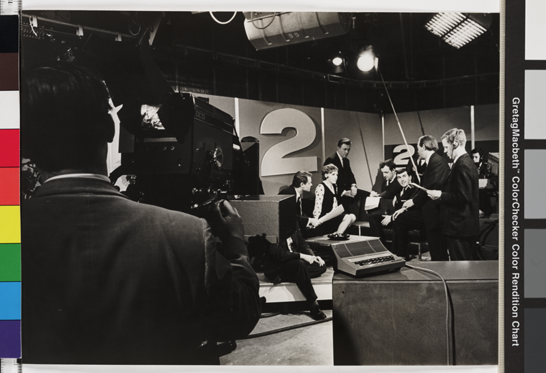
1970s
January 1971: The Open University begins broadcasting from the old BBC studios at Alexandra Palace.
1980s
29 July 1981: Biggest outside broadcast to date: the wedding of Prince Charles and Lady Diana Spencer (750 million viewers in 74 countries).
1 January 1982: New ITV contracts start. New companies include Central Television, TVS and TSW.
2 November 1982: Channel 4 television begins broadcasting.
17 January 1983: BBC Breakfast Time (breakfast television) starts.
2 November 1983: TV-AM breakfast television starts.
6 February 1989: Launch of Sky (satellite television provider).
1990s
29 April 1990: Launch of British Satellite Broadcasting (BSB) (satellite television broadcaster).
2 November 1990: Sky and BSB merge to form BSkyB.
1 January 1993: New ITV contracts start. New companies include Carlton Television, Meridian Broadcasting, Westcountry Television and GMTV. Old companies lost in the franchise change include TV-AM, TVS, TSW and Thames.
31 March 1997: Channel 5 begins broadcasting.
1 October 1998: BSkyB begins digital TV transmissions from a new generation of satellites as Sky Digital.
2000s
22 October 2002: UK’s Freeview free-to-air digital terrestrial television (DTT) service officially begins.
2 February 2004: Merger of Granada Television and Carlton Television is completed. The new company is named ITV plc.
27 May 2006: The BBC begins broadcasting in high-definition (HDTV) on their new subscription channel BBC HD.
17 October 2007: The gradual switch-off of all analogue terrestrial TV broadcasts begins in Whitehaven. The last regions will be switched off in 2012.
25 December 2007: The BBC launches iPlayer, an internet service for watching previously aired TV shows.
January 2008: Warner Home Video announces that it will support only Blu-ray Discs, setting off a chain reaction in favour of the format.
6 May 2008: The Freesat satellite service starts, including the first non-subscription HDTV channels.
2010s
30 March 2010: Freeview HD is launched across the UK, featuring the new Channel 4 HD.
1 October 2010: Sky launches Europe’s first stereoscopic (3DTV) television channel.
28 February 2011: Product placement is permitted on UK television for the first time.
2012–2013: The BBC sells Television Centre, and moves most of its operations from Television Centre to other BBC sites, particularly Broadcasting House and MediaCityUK in Salford. ITV plc also relocates many of its studios and operations from the Old Granada Studios to MediaCityUK, including the Coronation Street set.
4 January 2012: Netflix launches its movie and TV streaming service in the UK.
July–August 2012: London hosts the 2012 Olympics, and the BBC wins the UK contract to broadcast all Olympic tournaments up to 2020. Coverage of the Paralympic Games is broadcast on Channel 4 for the first time.
24 October 2012: The switch-off of all analogue terrestrial TV broadcasts completes in Northern Ireland.
2013–2016: Phase one of the Local Digital Television Programme Services (L-DTPS) sees new local television services launch in 21 local areas, licenced by Ofcom.
14 June 2013: The British Audience Research Board (BARB) announces it will include online viewing through catch-up services in its official viewing figures.
1 August 2015: Launch of BT Sports Ultra HD, the first 4K Ultra HD channel in the UK.
16 February 2016: BBC Three becomes online-only.
1 September 2016: A TV licence becomes a requirement for watching BBC iPlayer online.
1 January 2017: The BBC commences its renewed Charter, and from April Ofcom becomes the first external regulator for the BBC.
Note: this post was originally published in April 2011 and has subsequently been updated to reflect more recent developments.
The 1st and last pay tv service starts in Sheffield it is closed because it buys the rights to the grand national cutting of the rest of the country and is shut down
U.S satellites carry most signals from worldwide DVB.
Hello,
Who wrote this article? Thank you.
Hello Kate, as this post was published in 2011, unfortunately we no longer have any information about who wrote it. If you need to cite it you can do so in the following format:
National Science and Media Museum 2011, ‘A short history of British television’, viewed [today’s date], https://blog.scienceandmediamuseum.org.uk/history-of-british-television-timeline.
2030 BBC is no longer operational.
Did the BBC & ITV contemplate satellite TV and why were they prevented from sharing in the development?
Bsb it failed government wasted millions
They were not prevented as far as I know. They just failed to realise how important it would become. The BBC felt it got its fingers burnt and tried hard from then on to not get left behind by any new technologies. That was one reason they created iPlayer so early. They also made some efforts to get into 3D TV during its brief fad.
Might want to note that digital broadcasts had been happening since 1998 under the ondigital and itv digital names. 2002 saw the change and relaunch as Freeview.
I wonder if there is anyone out there who remembers seeing the coronation of George VI in 1937 on television, as I did at the age of 5? The set was home-built by my father who was a radio engineer.
Fascinating stuff! I was born in 1949 and we didn’t have TV till around 1959. The very few people who did have TV at that time were very popular and often friends’ houses had half a dozen kids, all sitting on the floor, to watch programmes like ‘Lassie’ etc. How times have changed!
Fascinating stuff! I was born in 1949 and we didn’t have TV till around 1959. The very few people who did have TV at that time were very popular and often friends’ houses had half a dozen kids, all sitting on the floor, to watch programmes like ‘Lassie’ etc. How times have changed!
Great informative resource. I wanted to know when satellite TV started in UK so just used the FIND tool (Ctrl+F) to search for the the word satellite and there was my answer on the fourth click – 6 February 1989: Launch of Sky (satellite television provider). And I can trust the source unlike so much of the internet!
Thank you so much!
Very interesting and informative, especially the early history of TV.
Does anyone remember a live rock concert being simultaneously broadcast on radio(in stereo sound) and on television using satellites from the other side of the world? I think it took place in the early eighties(or possibly late seventies?) and featured the British rock band Jethro Tull.
Watching Jools Holland’s Hootenanny, with Ruby Turner singing “Stay With Me Baby” the other evening, reminded us of a television series that we had watched in the 1980s. The beginning featured a woman walking into the sea, holding a baby, and with “Stay With Me Baby” being played.
A very vague bit of information, I’m afraid, but we remember enjoying the series and wonder if there’s a way of finding it again.
Hi..in August 1952 I saw TV for the first time at a friend of my grabs in Benthall ,Shropshire-it was-yes Andy Pandy!!..after that I never saw a TV till we got one in our family in January 1959-it was a 14 inch Ferranti portable set with indoor aeriel! The rental was £2 a month!
Us oldies will remember the atrocious childrens’ programmes: “Muffin the Mule”; that little pansy “Andy Pandy”; and “Billy the Belisha Beacon”. Things changed for the better when “Bill and Ben, the Flowerpot Men”{ started – Weeed!!
On a point of pedantry, S4C launched the day before Channel 4. There is an argument that you might have considered this and decided against listing it because it is specifically Welsh rather than British, as per the title of the web page, but then again you’ve listed (e.g.) the launch of the BBC in Scotland, so if you’re counting one and not the other then that’s a very nuanced position to take, :-)
I’ve been searching for a documentary aired between 94 and 98 about notting hill carnival sound system. I think it was norman jay or mean fiddler. I was I. The program dancing on the wall next to the sound system. I am black female had shaved afro wearing white vest top and light blue 501 jeans. Does anyone know the title and where I can find it please
i did thank you for your support
No mention of the old 405 line transmission coming to an end
What an evocative timeline. As a boy, in 1950, our Hornsey flat was half a mile south of the big Ally Pally mast. Signal was enormous. So I made a crystal set and listened sound only to Bill&Ben and Ben. 20 years later got a job recording location sound with the beeb. We trained in the news dubbing theatre. Can recall a sign at the top of the staircase “It is forbidden to climb the mast”. Just a wooden trapdoor – what a temptation.
The Kirk O’ Shotts Scottish transmitter went live in January of 1952, though officially BBC transmissions did not start till March. From January onwards, as kids, we would go into any shop selling TVs to watch the test transmissions. From the feed being shown down south, they showed coverage of the George VI funeral in February. This was despite BBC TV not officially having been launched in Scotland.
I remember watching the coronation of Queen Elizabeth II on a “PYE” 9 inch screen my parents bought specially for the occasion. Our “front room “ was filled with the neighbours.
When ITV started my father refused to get an adapter box, saying that the tv was not designed for it and once you started adding things to it, it never works the same again!
There is now strong evidence that UK tv development in the 1930s also had military objectives and was funded for that purpose.
See https://en.wikipedia.org/wiki/Isaac_Shoenberg?wprov=sfti1#Career
The CPS Emitron Camera pictured is not dated 1950 but was introduced into the BBC Lime Grove studios in 1956. The first EMI CPS Emitron camera is dated circa 1948 and was used at the 1948 Olympic Games.